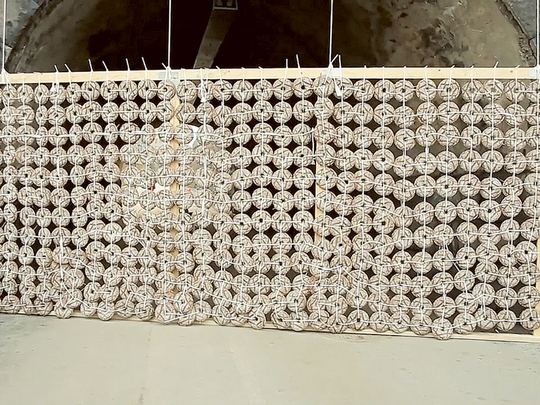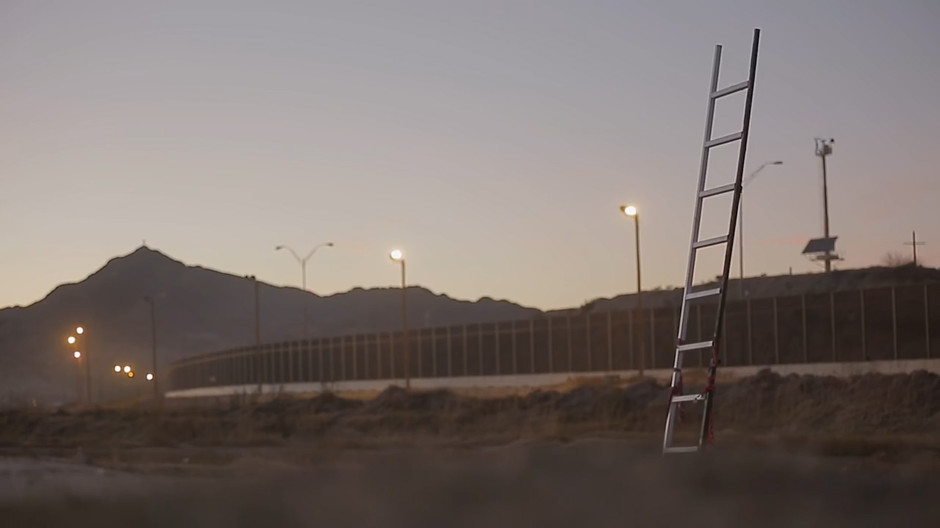
Khaled Jarrar was visiting the US when the country was in the middle of a divisive presidential campaign. Dismayed by the calls to build a wall along the US-Mexico border, the artist from Ramallah offered a different message by stealing a piece from the fence that already exists along the border, and transforming it into a ladder. The piece titled “Khaled’s Ladder” is installed in Juarez, close to the wall on the Mexican side.
As a Palestinian, Jarrar is familiar with walls and their impact on people’s lives. In his work, he has found innovative ways to address the subject of borders, particularly the elaborate system of checkpoints, fences and walls that have split communities in Palestine, through artworks such as his “Live and Work in Palestine” passport stamps; his award winning film “Infiltrators”, portraying the struggle of Palestinians to access basic necessities such as healthcare, education and jobs that are on the other side of the wall in Jerusalem; and his well-known “Upcycle the Wall” series, where he draws attention to the occupation of Palestine by making sculptures from concrete scraped off the apartheid wall that illegally annexes and cuts through parts of the West Bank. The artist has used the theme of Israeli occupation of Palestine as a starting point to explore the impact of modern-day power struggles on ordinary citizens, and to investigate militarised societies and the links between economic and state powers that fuel and profit from war and political conflict.
For his first exhibition in Dubai, “Castles Built from Sand Will Fall”, Jarrar has erected a huge concrete wall right across the gallery space. To view the show, visitors have to enter through an opening in the wall, shaped like the map of Palestine. Placed alongside the wall, is a replica of “Khaled’s Ladder”, standing as a powerful symbol of defiance and crossing barriers.
The show’s title, etched into a block of concrete, refers to the impermanent nature of politically imposed boundaries, which can be redrawn or demolished. The exhibition includes new and older works focusing on this issue, including videos displayed on screens placed inside concrete blocks, and in dark passageways, offering viewers an immersive experience of being confined by walls.
Jarrar spoke to Weekend Review about the issues he has addressed in his work. Excerpts:
What do walls mean to you?
The wall in Palestine came as an idea of humiliation, separation and control. But through my work I want to change that because I hate boundaries. I want to cross the walls and to interact with other people, and I will not let the walls stop me or be controlled by the fears. My work is not only about the walls in Palestine. As a citizen of Earth I want to speak against all the social, political, economic, religious and cultural walls that divide people. Powerful leaders and big businesses want to build walls for their selfish interests, but as the title of my show indicates these walls will eventually collapse. By building bigger and bigger structures we are destroying our environment and angering nature, and the result is global warming and calamities such as earthquakes and tsunamis that can destroy in a few minutes everything we have built.
What did you want to convey through “Khaled’s Ladder”?
This work is about transforming material that was used to separate people into a bridge that brings them together. The people who want to divide society use fear to first build mental walls before building metal walls. My ladder shows that human beings have the power to work together to dismantle these walls and to recycle the materials to build what we really need such as schools, hospitals and bridges. I also want to point out that the piece I appropriated from the US-Mexico fence was from a portion along the beach, and was heavily eroded by the sea. So, I have just continued what nature had begun. One side of the ladder has the rusted eroded metal. I have welded it with new metal and painted it white to highlight the stupidity of wanting a clinical white society devoid of diversity.
What was the idea behind the wall of bread that you installed in Finland?
This installation from 2014 is called “Hunger Wall” and is a visual representation of the unseen wall that exists between the rich and the poor. During the 1920s in post-war Finland, people used to make bread from a bark of a tree. Senior citizens told me that it tasted terrible but they had little else to eat. When I visited Finland, I was surprised to see that even today there are some areas where people are so poor that they queue up for handouts of bread. So, I strung together 386 loaves of Finnish rye bread to create a wall across an alley to make people stop and think about this disparity in their society, and to experience what it feels to be blocked by a wall in their path. My video about that installation shows senior citizens recalling the hard times and warning the younger generation not to take things for granted; and the reactions of ordinary Finns to the wall and the bread I handed out after dismantling the wall. I have also created a series of bronze sculptures of the loaves to highlight the fact that while this bread is a necessity for some, it is a luxury for others.
What is the significance of the bread in your video “Ka’ak Al Quds”?
This is a documentation of two boys smuggling loaves of the ringed sweet “Jerusalem bread”, which is like a symbol of the city, through a hole in the wall that divides the city. It shows that if people have the will they will find a way to surmount any wall. It took these children three hours to pass 1,000 loaves — one at a time — through the hole, but they still smiled for my camera. It touched my heart to see that two children had the power to defy the oppressive occupation and find a way to earn a living and survive.
What is the story behind “Journey 110”?
This video from 2008 was my first intervention with the wall, where I followed Palestinians who pass through a hidden 110-metre sewage-filled tunnel beneath the wall that snakes through the West Bank to reach the other side of a village divided by the barrier Israel built. These people have no political agenda. They just want to meet their families, go to school, pray at the mosque, get medical treatment, or just work on their farms on the other side. For me it was a surreal, near-death like experience to be walking in the dark tunnel, guided by a glimmer of light at the other end. The strength and resilience of these people in defying the wall inspired me to create art about this issue and to continue focusing on it.
Jyoti Kalsi is an arts-enthusiast based in Dubai.
“Castles Built from Sand Will Fall” will run at Ayyam Gallery, Alserkal Avenue, Al Quoz, until January 7, 2017.













